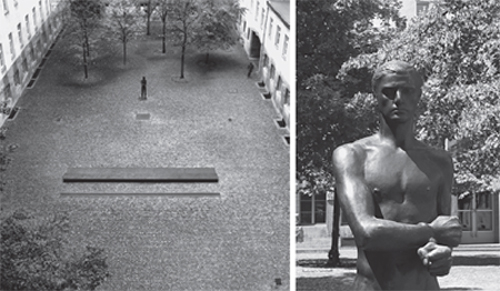Guide to Sites
The Bendlerblock in central Berlin, on the street now named Stauffenbergstrasse, was the focus of the putsch attempt on 20 July, and the scene of the execution of Claus von Stauffenberg, Friedrich Olbricht, Werner von Haeften, Albrecht Mertz von Quirnheim and the enforced suicide of Ludwig Beck. Although still the headquarters of the German Defence Ministry, it is today also the site of the ‘Gedenkstatte Deutscher Widerstand’ (GDW), ‘Memorial of the German Resistance’, an organisation that maintains a permanant exhibition in the second-floor offices where the drama was played out. Additional temporary exhibitions (all in German) are mounted elsewhere in the building complex. The courtyard that was the scene of the executions contains a symbolic statue of a bound and naked male figure and a plaque recording the names of the five men who died here. Official commemoration ceremonies honouring those executed, attended by leading representatives of the German state and descendants of the conspirators, are held here every 20 July. The GDW has a library of 5,000 photographs relating to the Resistance, and publishes books, biographies and other works on all aspects of the resistance to National Socialism – military, religious, the labour movement and young people. Special tours can be arranged (with a minimum of four weeks’ notice) and audio guides in English are also available.
| info@gdw-berlin.de | Tel: +49 30 26 99 50 00. |

The courtyard of Berlin’s Bendlerblock, today a memorial site.

Stauffenberg’s office in the Bendlerblock.
The GDW also maintains a memorial at Berlin’s Plötzensee Gefangnis (Plötzensee Prison) where some 3,000 victims of Nazism were executed – either guillotined or hanged. The victims included, besides some two hundred July plotters, members of the Red Orchestra Communist spy ring and the Czechoslovak Resistance. Although Plötzensee is still used as a jail, the execution chamber is kept as a permanant memorial.
The ‘Wolf’s Lair’ at Rastenburg (‘Wolfschanze’ – ‘Wilczy Szaniec’ in Polish), Hitler’s East Prussian headquarters, which was the scene of Stauffenberg’s bomb on 20 July, is also maintained as a memorial site in today’s Poland. Although attempts were made by the Nazis to destroy the complex – ironically with explosives – in November 1944 before the advancing Red Army reached it in January 1945, the concrete fortified bunkers were so massive that the demolition was only partially successful. Explanatory notices on the site guide today’s visitors around the overgrown scenes of Hitler’s living quarters and Stauffenberg’s assassination attempt.
| kontakt@wolfschanze.pl | Tel: +48 89 75 24 429. |
The homes of the Stauffenberg family, where Claus and Berthold von Stauffenberg spent their childhoods, are still extant at Schloss Lautlingen, in the Swabian Alps south of Stuttgart, where there is a small memorial chapel; and at the Altes Schloss [Old Castle] in Stuttgart’s city centre, both of which are open to visitors.
| info@landesmuseum-stuttgart.de. | Tel: +49 711 279 34 98. |
The picturesque Chateau La Roche-Guyon, Rommel’s French headquarters at the opening of the Normandy campaign until he was succeeded by Field-Marshal Kuge after being severely wounded, and the scene of Stülpnagel’s dramatic dinner with Kluge on the evening of 20 July, is open to visitors.
| information@chateaudelarocheguyon.fr | Tel: +49 1 34 79 74 42. |